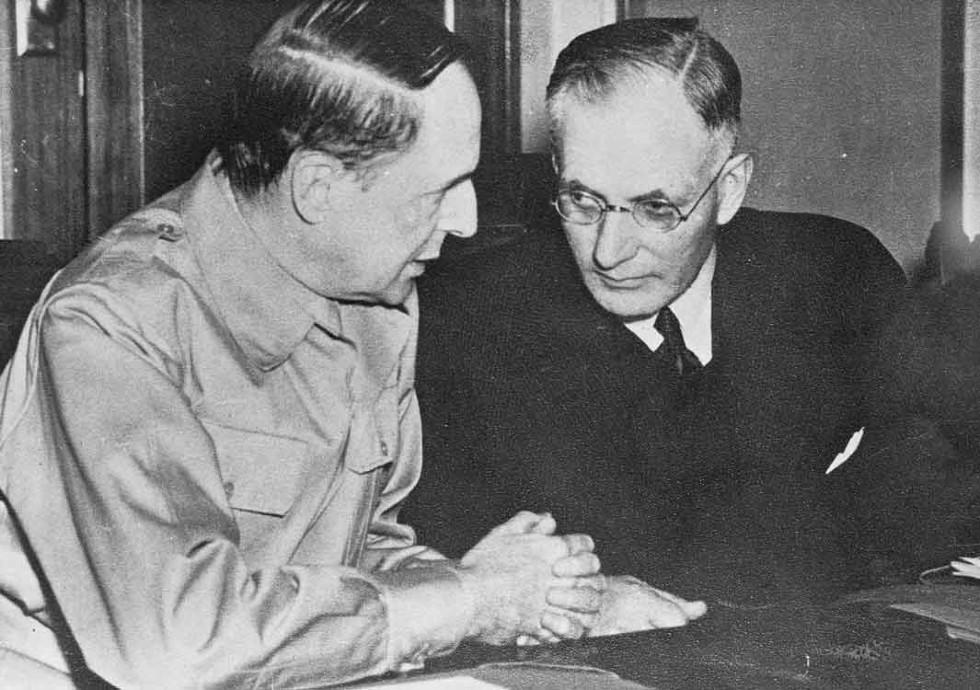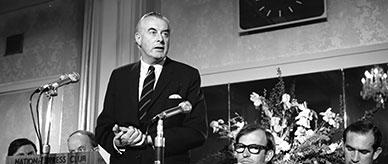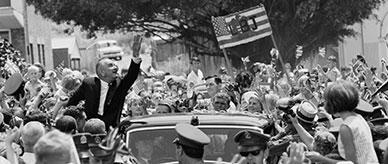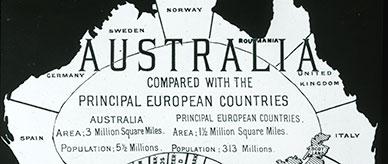


About this record
This is a photograph taken around 1944 of Prime Minister John Curtin in conversation with US General Douglas MacArthur, Supreme Commander of Allied Forces in the southwest Pacific theatre. Curtin wears a dark suit, white shirt and tie; MacArthur wears informal military uniform without insignia or badges.
Educational value
- Depicts John Curtin, Australia's 14th Prime Minister (1941–45) – Curtin led the Labor government during World War II, serving also as Chair of the Advisory War Council, member of the War Cabinet, Minister for Defence Coordination, Minister for Defence and, several times, Acting Minister for External Affairs; he died in office on 5 July 1945.
- Portrays the architect of 'the turn to America' – Curtin's main concern as Prime Minister in 1942, the darkest year of the War, some two years earlier than this photograph, was the redeployment of Australian troops from the Middle East to defend Australia from Japanese invasion; Curtin rejected the British strategy for Australia's participation in the war and insisted on seeking assistance from the USA.
- Shows Curtin in conversation with General Douglas MacArthur, Supreme Commander of Allied Forces in the southwest Pacific at the time – the most decorated soldier in US military history, MacArthur had a distinguished military career in the World War I and was promoted to US Army Chief of Staff in 1930; early in World War II, MacArthur commanded US forces in the Philippines that were defeated by the Japanese invaders and forced to withdraw, after which MacArthur pronouncing the famous words, 'I shall return'; when Curtin 'turned to America', the USA responded by sending MacArthur to Australia in March 1942.
- Probably shows Curtin and MacArthur in one of their regular conferences to discuss Allied strategy in the southwest Pacific zone – the close relationship between Curtin and MacArthur consolidated an Australian policy shift in that Australia turned its military focus from the European to the Asia–Pacific region, and allied itself more closely with USA than Britain, a shift that has influenced Australia's foreign policy from the postwar period to the present.
- Portrays MacArthur in 1944 – by that year, the tide of war had turned with Allied forces retaking Pacific islands from Japanese forces; MacArthur led US, Australian, Dutch and other Allied forces, from headquarters in Brisbane, in a successful campaign to retake the Philippines, stating 'People of the Philippines, I have returned'; this eventually led to the defeat of Japanese forces in the Pacific region and the ultimate surrender of Japan in September 1945.
- Depicts John Curtin about a year before the end of his career as Prime Minister and the end of his life – born in Victoria, Curtin moved to Perth, Western Australia, in 1917 to become editor of the Westralian Worker newspaper; he was an activist within the labour movement and an outspoken opponent of conscription in 1916–17; Curtin won the federal seat of Fremantle in 1928, serving in the Scullin Labor government, lost his seat in 1931 but regained it in 1934, holding it for the remainder of his career; Curtin succeeded Scullin as party leader in 1935 and led the Opposition until he became Prime Minister in October 1941.
Acknowledgments
Learning resource text © Education Services Australia Limited and the National Archives of Australia 2010.
Related themes
Need help with your research?
Learn how to interpret primary sources, use our collection and more.




